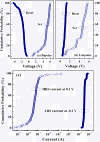Effect of non-lattice oxygen on ZrO2-based resistive switching memory
- PMID: 22416817
- PMCID: PMC3324381
- DOI: 10.1186/1556-276X-7-187
Effect of non-lattice oxygen on ZrO2-based resistive switching memory
Abstract
ZrO2-based resistive switching memory has attracted much attention according to its possible application in the next-generation nonvolatile memory. The Al/ZrO2/Pt resistive switching memory with bipolar resistive switching behavior is revealed in this work. The thickness of the ZrO2 film is only 20 nm. The device yield improved by the non-lattice oxygen existing in the ZrO2 film deposited at room temperature is firstly proposed. The stable resistive switching behavior and the long retention time with a large current ratio are also observed. Furthermore, it is demonstrated that the resistive switching mechanism agrees with the formation and rupture of a conductive filament in the ZrO2 film. In addition, the Al/ZrO2/Pt resistive switching memory is also possible for application in flexible electronic equipment because it can be fully fabricated at room temperature.
Figures









References
-
- Baek IG, Lee MS, Seo S, Lee MJ, Seo DH, Suh DS, Park JC, Park SO, Kim HS, Yoo IK, Chung UI, Moon JT. Highly scalable non-volatile resistive memory using simple binary oxide driven by asymmetric unipolar voltage pulses. IEDM Tech Dig. 2004. p. 587.
-
- Chen A, Haddad S, Wu YC, Fang TN, Lan Z, Avanzino S, Pangrle S, Buynoski M, Rathor M, Cai W, Tripsas N, Bill C, VanBuskirk M, Taguchi M. Non-volatile resistive switching for advanced memory applications. IEDM Tech Dig. 2005. p. 746.
-
- Lee HY, Chen PS, Wu TY, Chen YS, Wang CC, Tzeng PJ, Lin CH, Chen F, Lien CH, Tsai MJ. Low power and high speed bipolar switching with a thin reactive Ti buffer layer in robust HfO2 based RRAM. IEDM Tech Dig. 2008. p. 1.
-
- Li Y, Long S, Zhang M, Liu Q, Shao L, Zhang S, Wang Y, Zuo Q, Liu S, Liu M. Resistive switching properties of Au/ZrO2/Ag structure for low-voltage nonvolatile memory applications. IEEE Electron Device Lett. 2010;31:117–119.
LinkOut - more resources
Full Text Sources

